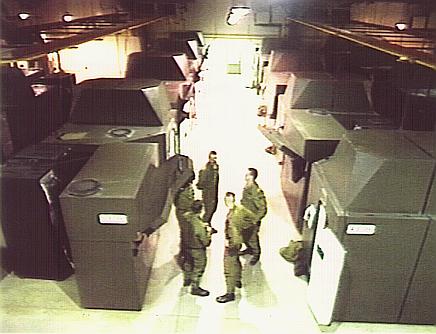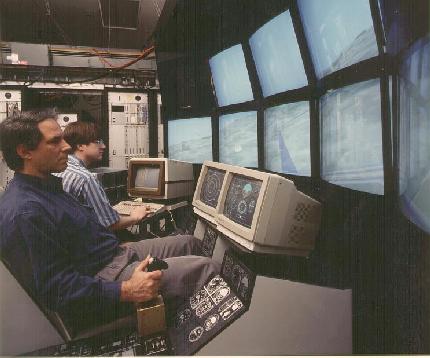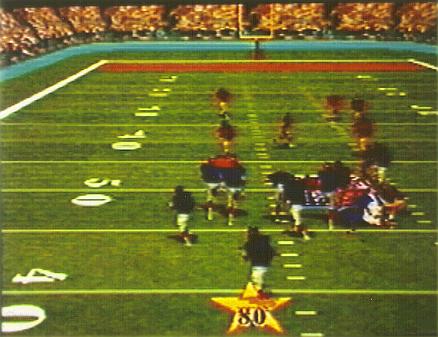
Abstract
Most valuable human activities require teamwork. But since most people are taught that collaboration is cheating, we are not learning the skills we need to succeed. And society is tending towards separateness, division and isolation.
Location Based Entertainments (LBEs) are highly seductive convergences of computer-human interfaces, 3-D graphics, visualization, simulation, and other technologies. In the amusement industry, convincing sensory illusions and natural interactivity can translate directly into fascination for players and profit for owners. But little is being done with all this technology. There is no deep value. Are these entertainments useful for anything besides improving hand-eye coordination and encouraging aggressive behavior?
Yes, of course. In this era of awesomely capable technologies, a remarkable opportunity exists to create new frameworks, scenarios, situations, and mythologies that enable collaboration and foster a sense of community. LBEs can deliver networked collaborative simulations to help people learn cooperation through play.
Introduction
Due in part to technological advances, behaviors and cultural norms are changing rapidly, and new opportunities to influence positive social changes are just beginning to appear. It now seems possible to combine concepts and techniques from apparently unrelated fields to develop entertainments that promote and encourage collaboration.
It is clear that, although some individuals may succeed by themselves, more certain wins for more people and organizations come from teamwork.. Its importance is obvious: most (80% or more) human work is cooperative work. But, in informal and formal education, individual performance is the most common pedagogical goal and basis for evaluation. We are trained into separateness.
Collaboration is traditionally treated as cheating, so most people enter the "real world" with little understanding or experience with working in groups. Yet teamwork is becoming legitimate as more people and organizations realize that collaboration is more beneficial than competition. How are people to learn the skills needed to form and exist in successful groups?
Social division and isolation are aggravated by many factors. Corporate marketing strategies are focused on ever-narrowing target groups, with the avowed goal of creating one-person market segments. The cocooning trend is now a decade old and still vigorously inspiring industries from food delivery to home health care.
These trends are causing our society to fall from an exciting metropolitan culture filled with amusement parks, picture palaces, dance halls - vital public group spaces and activities - into a repetitive sterile suburban landscape. The older urban entertainments nurtured a sense of community, however fleeting. Ethnic and regional differences could dissolve for a time as diverse individuals discovered their common identity as a "republic of pleasure seekers" [Nasaw]. This form of middle-class melding survived the Great Depression and two World Wars, but not white flight and the spread of commercial television. The mass audience has been carved into innumerable market segments based on age, race, sex, income ... We no longer have a coherent culture or a sense of belonging to a unified public.
But the most recent developments in entertainment technology promise to revitalize communal amusement, and at the same time help people learn and practice collaboration skills. The most promising of these technologies is high fidelity interactive simulation, of immense value for training and just beginning to appear in entertainment systems.
A Successful Collaborative Game
In the early 1980s, an Atari arcade game called Battlezone caught the attention of Defense Advanced Research Projects Agency (DARPA) planners who saw it as the basis for a simulation and training tool. The concept became SIMNET, a large-scale networked tactical training environment where human crew teams in realistic vehicle simulators interact and collaborate [figures 1, 2 and 3].
SIMNET was perhaps the world's first fully operational virtual reality system [Sterling] and has grown into today's worldwide distributed interactive simulation (DIS) environment. It supports a variety of air and ground vehicles, some human-directed and others autonomous, and pioneered fundamental DIS techniques like selective fidelity and remote vehicle approximation.

Figure 1: SIMNET simulators at Fort Knox, KY.

Figure 2: Inside a SIMNET aircraft simulator.

Figure 3: View "outside" a SIMNET aircraft simulator engaged in air-to-ground attack.
SIMNET is a successful collaboration training tool, albeit with a limited audience. Can we incorporate SIMNET-style immersive natural interaction into appealing and effective collaborative mass entertainments?
The Game Game
"Never forget: the engineers run the boat," said Nolan Bushnell, the founder of Atari. The vessel here is a pleasure cruiser: traditional amusements are being replaced and augmented by Location Based Entertainments (LBEs) elaborate attractions in theme parks, urban entertainment centers and elsewhere - because talented engineers are combining advanced interactive and 3-D technologies to produce them.
And this boat is fueled by profit. LBE entrepreneurs eagerly venture significant technology investments for a reasonable probability of substantial returns. Measures of success include capacity, repeat factor, satisfaction, and buzz (user testimonials). Investors, producers, owners, and operators want to attract and delight more customers, from more diverse groups, more often.
LBE designers are very focused on technology, often talking in rivers of highly specialized buzzwords: DOFs (degrees of freedom), perfs (film frame sizes), HDTV (high definition television), VR (virtual reality), cybermation (computer-driven animation mechanisms), pneumatics (air-powered animation), mechatronics (electro-mechanical apparatus), and so on. These are adjectives - they elucidate the parameters and dimensions of an LBE, but not its point. The deep experiences, the themes, the meanings are the nouns and verbs. The technologies define an open-ended "potential for limitless visual experience" [Kamberg]. But what unifies the experience? What guides the vessel to its destination? "It's the content, stupid" [Rundgren].
SIMNET's deep purpose is clear: train military personnel to cooperate effectively in tactical situations. In games and LBEs, the purpose is seldom clear because it is often nonexistent. Today's game technologies are highly sophisticated (sometimes even more so than in SIMNET), but often the scenarios are silly and the experiences unsatisfying. Many American stores have simple coin-operated "horsey rides" to amuse small children [figure 4]; current LBEs are far more sophisticated in form but no less juvenile in content - merely high tech "horsey rides."

Figure 4: A "horsey ride."
New Adjectives
If LBE content is to be enriched, several new adjectives become important in making the games easier and more fun to play: human interface, performance support, automatic translation, computer supported cooperative work, groupware.
To most users of most systems, the interface is the system. In a user-oriented system, the interface may not (and often should not) reflect the underlying functionality it supports. The basic interface commands for the modern automobile are faster, slower, and go backwards. Choke setting, spark advance, valve timing, mixture adjustment, and gear selection are irrelevant distractions to most drivers.
An LBE has practically no underlying functionality, and thus its human interface is its essence. The ideal LBE interface is lightweight: extremely easy to learn and use, and unobtrusive, with rapid unequivocal feedback and no irrelevant complexity. Keyboards and mice are clearly inappropriate; fortunately, more natural and transparent modalities are becoming practicable: gaze, gesture, voice, touch. Blackboarding and other associative techniques enable the combining of several input modalities to infer and confirm the user's meanings.
Performance Support (PS), simply put, "uses high-tech to help you do something, even though you might not care about technology nor know how to do the thing." PS is "help given at the moment of immediate pain." More formally, PS is task-oriented context-sensitive guidance and assistance, ideally presented through multimedia interaction. For LBEs, PS can make deep and interesting gam-play scenarios possible even in high-turnover situations. And PS can be made to adapt to individuals, e.g., each player might wear a transponder badge that informs the system about his/her preferred language and modalities, so instructions and status can be presented in the most understandable ways [Hettema].
Automatic Translation is not spirit writing but a way to accommodate different players' communication languages and styles. The only other solution, a common universal protocol, is probably unattainable since it would require an unlikely level of shared reality: the "universal" warning symbol for radioactivity [figure 5] prevents harm only to those who know its meaning. And our understanding of translation issues is expanding beyond English-to-French-to-Japanese to include modalities: speech-to-text-to-visualization. This technology is not yet ready for common use, but research results show promise.

Figure 5: The international warning symbol for radioactivity.
Computer Supported Cooperative Work (CSCW) addresses the impact of technology on groups and organizations: "How is technology used by groups?" Groupware focuses on the technology itself: "How is technology designed for groups?" "CSCW is the game (nouns, verbs) and groupware is the gear (adjectives)" seems workable. Networked simulations are groupware; their content is CSCW.
Where's the E?
Today, the "Entertainment" in typical LBEs is simplistic at best. Participants ("experiencers" is more accurate, since few LBEs are interactive) get quick action and high tension: Slash, kick, throw, race, duel, slam, chase, and most of all compete [figure 6]. All this favors a demographically narrow audience: male, age 14-24, combative, individualistic. These games are boy toys - "Women need a reason for conflict, men only need a place." [Wiseman]. Because the focus is on competition, there must inevitably be an eventual winning or losing, after which the experience becomes dull. And it is difficult to be entertained by simply observing; watchers are usually trying to learn how to win. "None of this is as much fun as Coney Island in its heyday." [Nasaw].

Figure 6: A competitive and violent scene in a contemporary game.
What do People Want?
To construct entertainments that will attract players and generate
revenue - essential to a game's success regardless of its social value - it
is essential to understand what qualities customers prefer. We have surveyed
hundreds of people (including LBE producers) to gain a sense of the amusements
and games they like and dislike: The most prevalent responses were:
Few respondents express a preference for today's harsh, often competitive and violent LBE experiences. It is clearly time to go "... back to the basics: great ideas." [Kamberg].
Opportunity
We have the opportunity to influence what players will take away from their entertainment experiences. LBEs can promote cooperative learning by exploiting "the strong web of connections joining commercial play and cultural cohesion" [Nasaw] as well as the powerful relationships between education and entertainment.
Some examples of LBE themes (nouns, verbs) that would require cooperation and so help impart the necessary skills might be: trapeze flying and other circus stunts, tug o' war, team sports, high finance; join, dance, play music, create, invent.
The public is increasingly concerned about the negative influence of violent and competitive games; governments threaten censorship, and the amusement industry has responded with proposals for rating systems. Surely a more sensible and cost-effective response is to develop games that exert positive influence and teach valuable skills.
Game Design for Collaboration
To help create LBE environments amenable to cooperative behavior,
we suggest some new structural components that would permit players to interact
on their own terms while operating within relatively fixed structures. Most
of these components would incorporate performance support and other techniques
discussed above. We have listed them roughly in increasing order of technical
complexity.
Encouraging Trends
Several significant entertainment industry trends encourage
the development of collaborative gaming:

Figure 7: A collaborative game.
Conclusion
The exciting possibility now exists to develop a new social bond based on collaboration-focused activities and supported by advanced technology. The Channel Tunnel (Chunnel), the North American Free Trade Agreement (NAFTA), the European Common Market (EU), and the General Agreement on Tariffs and Trade (GATT) are among the many hopeful signs of a worldwide movement towards cooperation and unification. LBEs and other social amusements can support this motion while delivering terrific entertainment and providing players with satisfying experiences, investors with great profits, and society with well prepared contributors.
Acknowledgments
The author wishes to thank Clark Dodsworth and haila darcy
for their unflagging encouragement and support.
Phil Hettema (Vice President for Attraction Development, Universal/MCA Studios), remarks in panel discussion at 1993 SIGGRAPH Conference.
Mario Kamberg (Director/Designer, MCA Recreation Services), remarks in panel discussion at 1993 SIGGRAPH Conference.
Bill Machrone, "What's Wrong with Multimedia," in PC Magazine, November 9, 1993.
David Nasaw, Going Out: The Rise and Fall of Public Amusements, 1993 (New York), Basic Books.
Walter Parkes, "Random Access: The Evolution of Storytelling," in Omni Magazine, December 1993.
Todd Rundgren (musician), remarks in live performance in Atlanta, GA, 1994.
Bruce Sterling, "War is Virtual Hell," in Wired, Premier Issue, 1993.
Douglas Trumbull (LBE designer and developer), in The New York Times, January 31, 1994.
Jordan Wiseman (founder, BattleTech Inc.), in Wired,
Premier Issue, 1993.
About the Author
Michael Harris is a video and interactive producer, LBE and game developer, system architect, and theatrical designer. He was one of the original contributors to the SIMNET networked simulation environment. He is presently developing corporate themed attractions, interactive systems with adaptive dynamic interfaces, and group support systems.